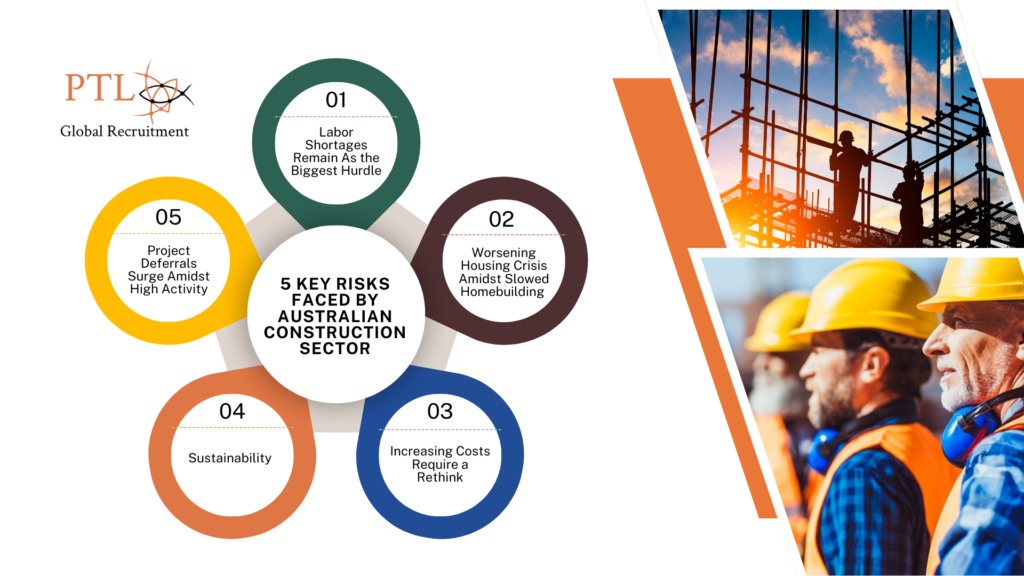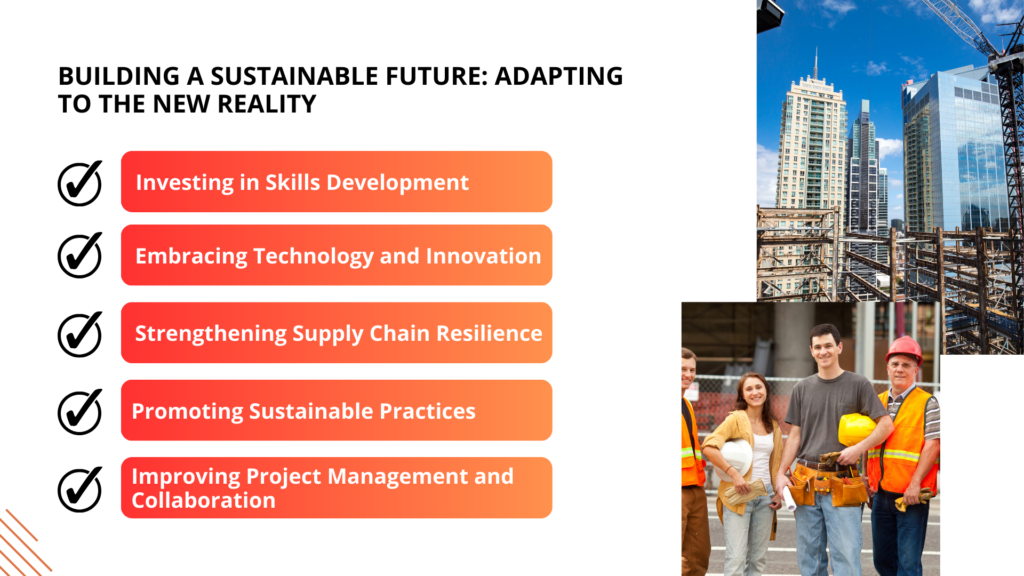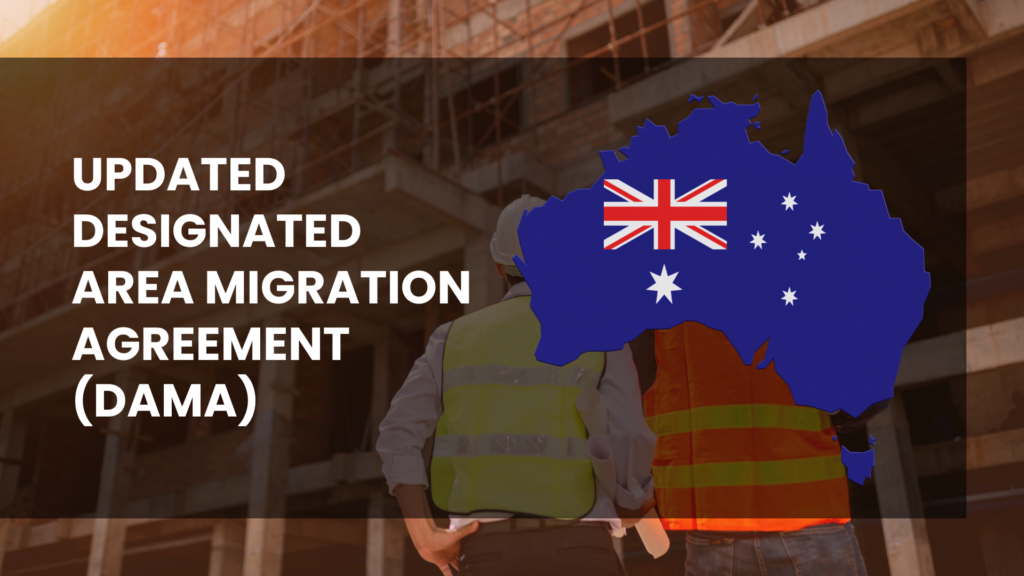The construction sector in Australia is experiencing unprecedented demand, fueled by factors like population growth and extensive infrastructure development. While this surge offers lucrative opportunities, it also poses significant challenges, such as skills shortages, supply chain disruptions, and escalating material costs. Navigating these dynamics is essential to ensuring sustainable growth in Australia’s construction sector.
Facing a critical shortage of skilled tradespeople, leading Australian construction organisations are calling for government intervention to increase skilled migration. The current deficit across twelve trades is impacting housing affordability and hindering the delivery of new homes, according to industry representatives.
Master Builders Australia estimates the construction sector Australia needs at least 500,000 additional workers by 2029 just to meet existing demand. This figure doesn’t factor in the ambitious goals of the national housing accord, the transition to net zero emissions, or other future projects, further highlighting the urgency of the situation. The high demand anticipated for the industry is also reflected in a Research and Markets report. It said, Australia’s construction output is expected to reach AUD 246.06 billion by 2028, indicating a substantial growth potential.
Major Risks Faced by Australian Construction Sector

The latest BCI Construction Outlook identifies five key risks currently impacting the Australian construction industry.
Labor Shortages Remain As the Biggest Hurdle
An overwhelming 90% of builders surveyed identified labor shortages as a primary business risk. This scarcity of skilled workers impacts project timelines and necessitates pricing these risks into project feasibility. Retaining existing talent is crucial, but the ongoing struggle to find skilled subcontractors adds pressure and impacts delivery schedules. Although opinions vary on when this constraint might ease. Master Builders CEO Denita Wawn calls the situation “extraordinarily desperate,” urging the government to prioritise skilled migration as an immediate solution.
Worsening Housing Crisis Amidst Slowed Homebuilding
Australia’s housing crisis is exacerbated by increased migration and ambitious targets of 1.2 million new homes within five years. Industry professionals suggest easing regulations, reducing interest rates, and increasing land releases. Strategic building along transit corridors and growth areas is also recommended.
Furthermore, a review of the planning system and the development of more flexible, adaptable housing typologies are crucial. The growing build-to-rent sector, fueled by institutional investment, offers a potential solution.
HIA senior economist Matt King emphasises the nationwide labor shortage’s impact on new home building, driving trades prices up 3.4% annually compared to the pre-pandemic average of 2%.
Competition for workers is fierce, fueled by non-residential construction and government-funded projects. Bricklaying, tiling, plastering, and carpentry face the most acute shortages. Both HIA and Master Builders advocate streamlining pathways for Australians to enter the industry while emphasising immigration as a crucial short-term fix.
Increasing Costs Require a Rethink
Cost escalation is the biggest risk for nearly 80% of the developers. This risk is followed closely by contractor insolvency. Inflation, material costs, and labor shortages strain fixed-price contracts and profit margins.
Securing funding, development approvals, and finding builders with manageable pricing are significant challenges. The industry needs to rethink its approach to cost management and risk mitigation in this volatile environment.
Sustainability
While the Australian construction industry is increasingly adopting energy-efficient products and low-embodied carbon measures, rising material costs create tension between environmental goals and budget constraints.
Now, a shift in mindset is underway, challenging the perception of sustainability as a luxury rather than a necessity. However, a lack of focus, misdirection, and inconsistent understanding threaten to dilute key environmental objectives.
Project Deferrals Surge Amidst High Activity
A concerning trend is the rise in project deferrals, especially in the residential, commercial, and hospitality sectors, which now exceed abandonment rates. While abandonments appear to be declining, the simultaneous increase in deferrals highlights growing challenges for the industry.
Navigating the Construction Skills Shortage: Government Initiatives
Facing a nationwide shortage of skilled tradespeople, securing talent for upcoming construction projects is crucial. State and federal governments are stepping in to assist employers, offering incentives and streamlined visa processes for international hires. Here’s how you can benefit:
Western Australia: Perth’s designation as a regional demand area simplifies access to overseas talent, facilitating smoother workforce integration statewide.
Victoria: The state is actively developing solutions to help employers in the construction and manufacturing sectors secure the skilled labor they need, focusing on boosting productivity.
On the national front, the Australian government recently issued 10,000 skilled construction visas – the highest number in a decade. However, even this significant increase only partially addresses the massive demand driven by the new home building target and other major infrastructure projects.
Building a Sustainable Future: Adapting to the New Reality

To ensure the long-term health and prosperity of the Australian construction industry, several key strategies are essential:
Investing in Skills Development
Addressing the skills shortage requires a concerted effort to attract skilled migration, upskill existing workers, and promote vocational education and training. Collaboration between industry, government, and educational institutions is crucial to create effective training programs and pathways.
Embracing Technology and Innovation
Adopting innovative technologies like Building Information Modeling (BIM), prefabrication, and modular construction can improve efficiency, reduce waste, and enhance productivity. These technologies can also address labor shortages by automating certain tasks and streamlining processes.
Strengthening Supply Chain Resilience
Diversifying supply chains, exploring local sourcing options, and building stronger relationships with suppliers can mitigate the impact of future disruptions. Investing in robust logistics and inventory management systems is also essential.
Promoting Sustainable Practices
Integrating sustainable principles into project design, construction, and operation is crucial for reducing environmental impact and meeting evolving regulatory requirements. Adopting circular economy principles, utilising recycled materials, and minimising waste are essential components of a sustainable approach.
Improving Project Management and Collaboration
Effective project management, transparent communication, and strong collaboration between stakeholders are crucial for navigating the complexities of the current market. Implementing robust risk management strategies can help anticipate and mitigate potential challenges.
The Future of Construction: A Call for Collaboration and Innovation
The unprecedented demand in the Australian construction industry presents both opportunities and challenges. By addressing the skills shortage, strengthening supply chain resilience, embracing innovation, and promoting sustainable practices, the industry can navigate the current landscape and build a stronger, more sustainable future. Collaboration between government, industry, and educational institutions will be essential for achieving these goals and ensuring that Australia’s construction sector continues to thrive.
Why Partner with PTL Global Services?
For over two decades, PTL Global Services has specialised in connecting Australian businesses with skilled international talent. We understand the urgent need for reliable, long-term employees. That’s why we focus on recruiting dedicated professionals who are not only qualified and eager to work but also committed to making Australia their permanent home.
Partnering with PTL Global Services delivers more than just filling vacancies; it provides access to a stable, committed workforce ready to contribute to your company’s long-term success. We offer a pathway to a skilled and settled team equipped to meet the challenges of tomorrow.
Contact PTL Global Services Today
Let us help you secure the talent you need to thrive. Contact us by phone or email to discuss your specific requirements and discover how we can help you build a stronger, more capable team.





